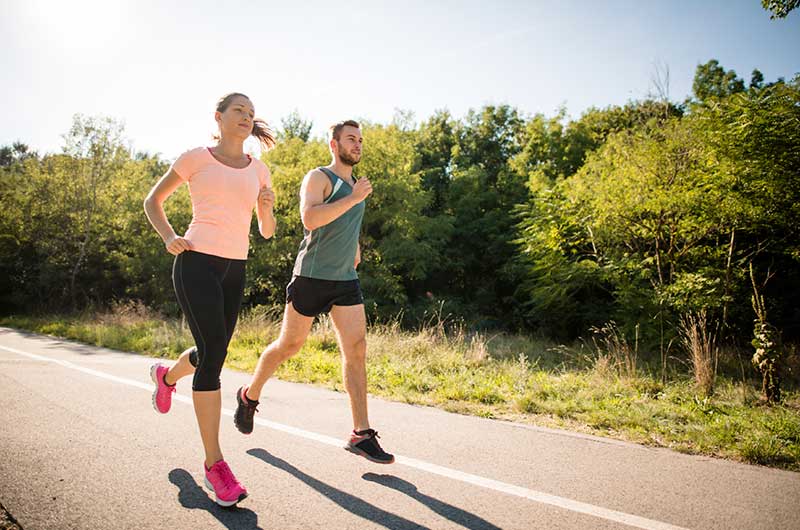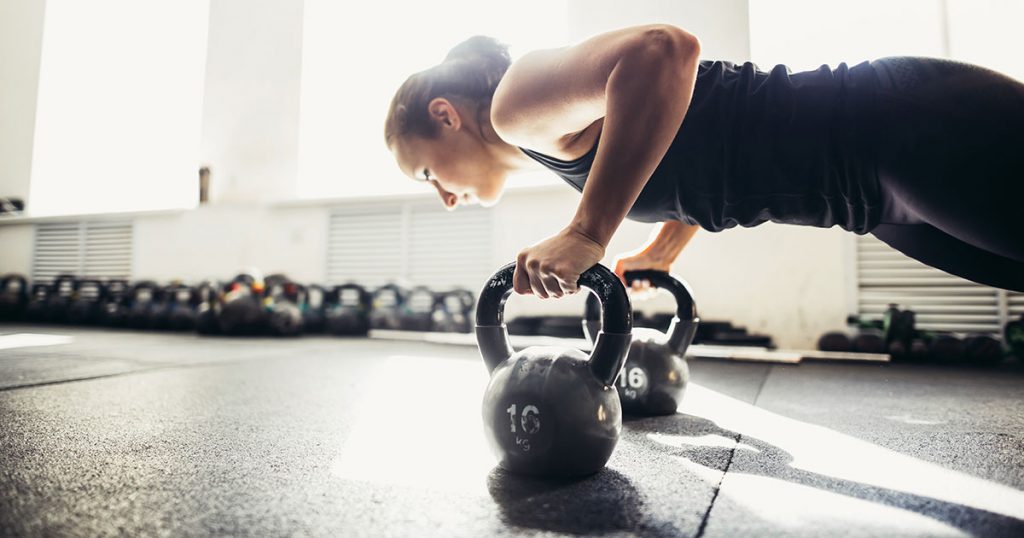What Is Physical Fitness?
Physical fitness can be defined as a set of characteristics that are either health-related or skill-related. It refers to your ability to perform physical tasks efficiently as it relates to a particular sport or your day-to-day activities. In addition to physical health, being physically fit helps improve your mental, emotional, and social health. You already know that benefits come when you prioritize physical fitness. The trick is understanding what, exactly, “fitness” is and how you can go about achieving it.That’s where the five components of fitness come in. They are the blueprint for the American College of Sports Medicine’s (ACSM’s) physical activity guidelines and serve as a helpful tool for organizing and executing your own well-balanced workout routine.
In many studies related to physical fitness and health, researchers have focused on exercise, as well as on the more broadly defined concept of physical activity. Physical activity is defined by the World Health Organization as any bodily movement produced by skeletal muscles that requires energy expenditure, while exercise is a form of physical activity that is planned, structured, repetitive, and performed with the goal of improving health or fitness. So, although all exercise is physical activity, not all physical activity is exercise. Although physical activity and exercise are defined concepts, the ultimate focus of the health related components of physical fitness is to provide a framework for components that are necessary for good health. They are cardiorespiratory (CR) endurance (also called aerobic endurance), flexibility, muscular strength, muscular endurance, and body composition.
5 Components of Physical Fitness
- The 5 components of physical fitness are often used in our school systems, health clubs and fitness centers to gauge how good a shape we are truly in. The 5 components that make up total fitness are:
- Cardiovascular Endurance
- Muscular Strength
- Muscular endurance
- Flexibility
- Body Composition
Health-Related Physical Fitness
Health-related physical fitness is primarily associated with disease prevention and functional health. Participating in regular health-related fitness helps you control your weight, prevents diseases and illness, improves your mood, boosts energy, and promotes better sleep.
It is made up of five sections: cardiovascular endurance, muscular strength, muscular endurance, flexibility, and body composition. Lets take a closer look at the five sections of health-related fitness:
Cardiovascular endurance is the ability of your heart, blood cells, and lungs to work continuously for extended periods of time. This is how efficiently your body takes in, transports, and uses oxygen while exercising. Having efficient heart and lungs leads to increased energy throughout the day.
Muscular strength is the maximum amount of force a muscle can produce in a single effort or how much you can lift in one attempt. Performing exercises that use your own body weight, free weights, or weights on a machine are excellent ways to develop muscle strength. Having muscular strength will ensure that you have the strength needed to lift a heavy object, for example a box full of books.
Muscular endurance is your ability to contract your muscles several times without excessive fatigue. Another way to think about it is the length of time your muscles can continue to work before tiring. What this means is once you have picked up that heavy box of books, you can then carry that box for a long period of time before you need to take a break.
Flexibility is the range of motion that your joints have during movement. Maintaining flexibility can improve your performance in physical activities in addition to decreasing your risk of injuries by helping your joints move through their full range of motion, therefore, allowing your muscles to work most effectively. Stretching and yoga can be done to help improve your flexibility.
Body composition is the ratio of water, bone, muscle, and fat in the body. A healthy body composition indicates that you may have less risk of developing obesity-related diseases, such as diabetes, high blood pressure, and even some cancers.
Two of the ways to measure body composition are body mass index, (BMI), which is a measure of body fat based on height and weight, and the skin fold test, which measures total fat percentages by measuring the layer of fat that is directly under the skin.
Skill-Related Physical Fitness
Skill-related physical fitness is the ability to perform during games and sports; it is also called performance fitness. This type of physical fitness is important for performing the more technical aspects of many sports. There are six skill-related physical fitness sections: agility, balance, coordination, power, reaction time, and speed.
Health Related Components of Physical Fitness
Examining the Relationship Between Physical Activity and Health
In many studies covering a wide range of issues, researchers have focused on exercise, as well as on the more broadly defined concept of physical activity. Exercise is a form of physical activity that is planned, structured, repetitive, and performed with the goal of improving health or fitness. So, although all exercise is physical activity, not all physical activity is exercise.
Studies have examined the role of physical activity in many groups—men and women, children, teens, adults, older adults, people with disabilities, and women during pregnancy and the postpartum period. These studies have focused on the role that physical activity plays in many health outcomes, including:
- Premature (early) death;
- Diseases such as coronary heart disease, stroke, some cancers, type 2 diabetes, osteoporosis, and depression;
- Risk factors for disease, such as high blood pressure and high blood cholesterol;
- Physical fitness, such as aerobic capacity, and muscle strength and endurance
- Functional capacity (the ability to engage in activities needed for daily living);
- Mental health, such as depression and cognitive function; and
- Injuries or sudden heart attacks.
These studies have also prompted questions as to what type and how much physical activity is needed for various health benefits. To answer this question, investigators have studied three main kinds of physical activity: aerobic, muscle-strengthening, and bone-strengthening.
Aerobic Activity
In this kind of physical activity (also called cardiorespiratory fitness), the body’s large muscles move in a rhythmic manner for a sustained period of time. Brisk walking, running, bicycling, jumping rope, and swimming are all examples.
Aerobic activity causes a person’s heart to beat faster than usual.
Aerobic physical activity has three components:
- Intensity, or how hard a person works to do the activity. The intensities most often examined are moderate intensity (equivalent in effort to brisk walking) and vigorous intensity (equivalent in effort to running or jogging);
- Frequency, or how often a person does aerobic activity; and
- Duration, or how long a person does an activity in any one session.
Muscle-Strengthening Activity
This kind of activity, which includes resistance training and lifting weights, causes the body’s muscles to work or hold against an applied force or weight. These activities often involve relatively heavy objects, such as weights, which are lifted multiple times to train various muscle groups. Muscle-strengthening activity can also be done by using elastic bands or body weight for resistance (climbing a tree or doing push-ups, for example).
Muscle-strengthening activity also has three components:
- Intensity, or how much weight or force is used relative to how much a person is able to lift;
- Frequency, or how often a person does muscle strengthening activity; and
- Repetitions, or how many times a person lifts a weight (analogous to duration for aerobic activity). The effects of muscle-strengthening activity are limited to the muscles doing the work. It’s important to work all the major muscle groups of the body: the legs, hips, back, abdomen, chest, shoulders, and arms.
Bone-Strengthening Activity
This kind of activity (sometimes called weight-bearing or weight-loading activity) produces a force on the bones that promotes bone growth and strength. This force is commonly produced by impact with the ground. Examples of bone-strengthening activity include jumping jacks, running, brisk walking, and weight-lifting exercises. As these examples illustrate, bone-strengthening activities can also be aerobic and muscle strengthening.
Overall Components of Physical Fitness
5 MAIN COMPONENTS OF PHYSICAL FITNESS
- Cardiorespiratory fitness – ability to sustain aerobic activity for a prolonged period of time
- Muscular strength – amount of force a muscle is able to exert in one contraction
- Muscular endurance – ability of the muscle to continue to perform without fatigue
- Flexibility – ability to move joints freely through their full range of motion
- Body Composition – the relative proportions of fat mass and lean mass in the body

















1 Comment
Comments are closed.